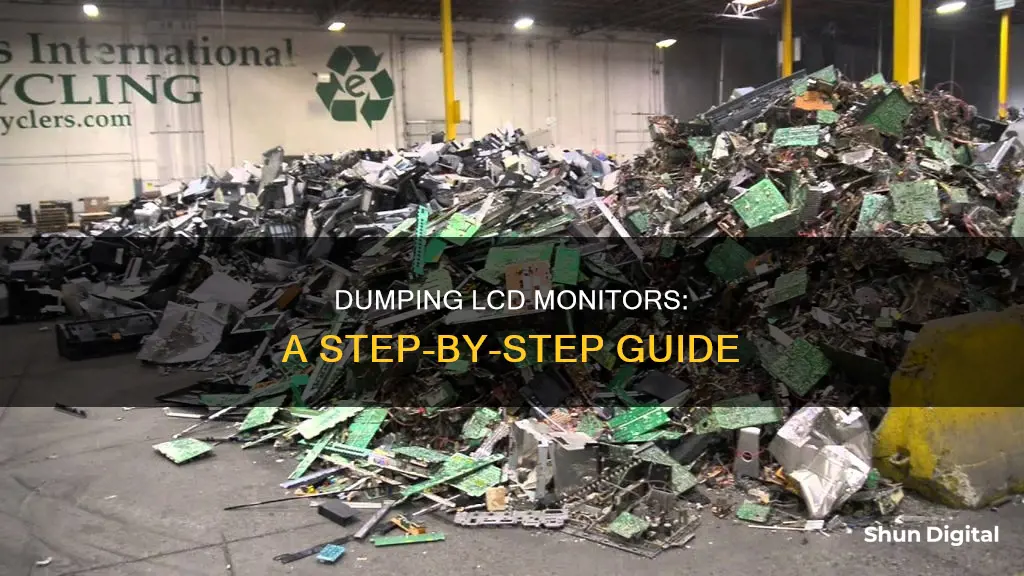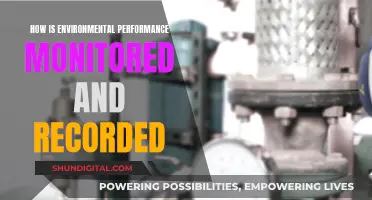
LCD monitors contain toxic substances such as lead, mercury, and flame retardants, which can cause serious harm to the environment and human health if not disposed of properly. With the average lifespan of an LCD monitor being around 5 years, it is important to know how to safely dump an LCD monitor to prevent toxic chemicals from leeching into the earth.
| Characteristics | Values |
|---|---|
| Average Lifespan | 5 years |
| Repairability | Difficult to repair |
| Toxic Components | Lead, mercury, cadmium, copper leach, flame retardants |
| Disposal | Reuse, recycle, donate, sell |
| Environmental Impact | Air pollution, water contamination, soil contamination, developmental risks, loss of valuable resources |
What You'll Learn

Unplug cables and power cord
Unplugging cables and power cords is an important step in the process of dumping an LCD monitor. This step is crucial not only for safety reasons but also to prepare the monitor for recycling or disposal. Here are some detailed instructions on how to go about it:
First and foremost, ensure that the LCD monitor is switched off and unplugged from the power source. This initial step is essential for your safety as it eliminates the risk of electrical shocks. Additionally, it makes the process of unplugging cables safer and more convenient.
Now, let's move on to identifying the cables that need to be unplugged. Start by locating the DVI, HDMI, or VGA cable that connects the monitor to the CPU. Proceed to unplug this cable, being careful not to damage either the monitor or the CPU. In the case of a VGA cable, you might need to unscrew the ends before you can unplug it.
After addressing the primary cable connections, shift your focus to the power cord. If the power cord is removable, go ahead and unplug it from the monitor. Remember to handle the power cord with care, as it may have a built-in strain relief or latch that needs to be released before unplugging.
Once all the cables and the power cord have been successfully unplugged, it's a good idea to tie or wrap them neatly. This simple step helps prevent tangles and makes it easier for you or anyone else to manage the cables during transportation or storage.
Finally, be cautious not to break any part of the LCD monitor while unplugging the cables and power cord. LCD monitors contain toxic substances such as lead, mercury, and flame retardants. Therefore, preventing any leakage of these hazardous materials is crucial for the safety of both yourself and the environment.
Monitor Smart TV Data Usage: Tips for Parents
You may want to see also

Transport to car safely
When transporting an LCD monitor to your car, it is important to be cautious to avoid damaging the equipment. Here are some detailed steps to ensure safe transportation:
Firstly, unplug all cables, including the DVI, HDMI, VGA, and power cord to reduce the weight and prevent tripping. If possible, keep the original packaging, as this is designed to protect the monitor during transportation. If you no longer have the packaging, use a suitable alternative such as a box or sturdy container. Place the monitor inside, ensuring it is securely wrapped in a blanket or towel to provide extra cushioning.
When carrying the monitor to your car, be cautious and maintain a firm grip. Place the monitor in the back seat or trunk of your car, ensuring it is secure and won't slide or tip over. If placing it on a seat, lay it flat, screen-side down, and cover it with a blanket or towel. This will protect the screen from scratches and prevent damage if you need to brake suddenly.
If you have a particularly large or heavy monitor, consider using a dolly or rolling chair to move it to your car. Additionally, you can use straps or seat belts to secure the monitor in place, ensuring it won't move during transport.
By following these steps, you can safely transport your LCD monitor to your car, reducing the risk of damage to your equipment.
Removing Rubber Covers from Your ASUS Monitor Easily
You may want to see also

Find a drop-off location
When looking for a drop-off location to dispose of your LCD monitor, it is important to consider the various options available. Here are some detailed suggestions to help you find a suitable drop-off location:
Retail Store Recycling Programs
Many major electronics retailers now provide in-store recycling programs where you can drop off computer monitors, laptops, TVs, and other electrical items. For instance, Staples and Best Buy have free electronics recycling services and will accept items such as monitors, laptops, ink cartridges, printers, and hard drives. Some stores may charge a fee for recycling monitors, such as Best Buy, which typically charges $25. Additionally, stores like Staples offer store credit for recycling certain electrical items.
Manufacturer Recycling Programs
Many computer manufacturers, including Apple, Dell, Hewlett Packard (HP), and IBM, have their own recycling programs. These companies often provide drop-off locations or allow you to ship your old monitor to them for recycling or refurbishment. For example, Dell offers both drop-off and mail-in options, accepting any brand of monitor or other electronic products. HP provides a free recycling service for all HP and Compaq devices, while Apple has a trade-in program where you can receive money for returning old devices.
Municipal Waste Centers
Although curbside recycling programs for monitors are rare, many municipalities have designated drop-off centers with electronics recycling programs. In California, for instance, there is a program called CalRecycle, where you can find a municipal e-waste center near you to drop off your old monitor.
E-Waste Collection Drives
In larger cities, organizations or municipal agencies occasionally host e-waste collection drives where you can dispose of your old computer equipment for a small fee or sometimes for free. These drives are typically organized in areas lacking regular e-waste collection facilities, providing an alternative option for safe disposal.
Specialized Recycling Companies
Specialized e-waste recycling companies, such as Recycle Technologies and GreenCitizen, offer dedicated services for recycling old electronics. They have the necessary industrial machinery to safely dismantle and recycle monitors and other electronic devices. Recycle Technologies has facilities in New Berlin and Blaine, serving residents of Wisconsin and Minnesota, while GreenCitizen is based in the San Francisco Bay Area. Both companies provide detailed instructions on their websites for dropping off or shipping your old monitors to their facilities.
ASUS MB168B Monitor and ASRock Motherboard: A Perfect Match?
You may want to see also

Recycle or donate
LCD monitors contain hazardous materials such as lead, mercury, flame retardants, and volatile organic compounds. When not disposed of properly, these substances can be released into the environment, impacting human health, the mental development of children, and the planet's natural resources. Therefore, it is important to recycle or donate your LCD monitor to ensure it does not end up in a landfill.
Recycling
To recycle your LCD monitor, follow these steps:
- Disconnect the monitor from the PC and any power sources.
- Clean the monitor with a microfiber cloth and an ammonia-free glass cleaner. Avoid using abrasive cleaners or paper towels, which could scratch the screen.
- Wrap the monitor in a towel or blanket to protect it during transport.
- Find a recycling centre that accepts LCD monitors. Many electronic waste (e-waste) recycling centres or local businesses will take LCD monitors. Major retailers such as Staples and Best Buy also accept LCD monitors for recycling.
- Transport the monitor to the recycling centre, ensuring it is balanced on a smooth surface and secured in your vehicle to prevent damage.
Donating
If your LCD monitor is still in working condition, consider donating it to a charity or an organisation that can distribute it to someone in need. This option is environmentally friendly and ensures that your monitor will continue to be used by someone who needs it. Before donating, make sure to:
- Check that the monitor is in reasonable shape and working condition.
- Remove any personal data from the device.
- Contact a local charity or organisation, such as Goodwill, to inquire about their donation process and provide them with details about your device's age and specifications.
Choosing the Right Monitor Size for Programming Work
You may want to see also

Consult experts
If you're unsure about how to dispose of your LCD monitor, it's always best to consult an expert. Many companies and organisations offer professional advice and services for the safe disposal of electronic waste, including LCD monitors. Here are some steps and guidelines to follow when seeking expert assistance:
- Contact Local Authorities: Reach out to your local waste management authorities or environmental agencies. They can provide you with information on approved disposal methods, regulations, and certified recyclers in your area. In some regions, local governments organise electronic waste collection events or have designated drop-off locations for items like LCD monitors.
- Engage Professional Recyclers: Look for professional electronic waste recyclers in your area. Reputable companies, such as Hummingbird International, offer specialised services for the safe disposal of LCD monitors and other electronic waste. They will have the expertise and resources to handle the recycling process properly, ensuring that toxic components are handled and treated with care.
- Inquire about Certifications: When choosing a recycler, ask about their certifications and credentials. Reputable recyclers will often hold certifications like the Basel Action Network's (BAN) e-Stewards certification or Sustainable Electronics Recycling International's (SERI) R2 Standard. These certifications provide assurance that the recycler adheres to responsible recycling practices and does not export electronic waste overseas.
- Understand the Process: Ask the recycler about their specific processes for handling LCD monitors. A good recycler will be transparent about their methods, which may include removing hazardous waste materials, refurbishing devices, or breaking down devices to recycle various components. Understanding their process will give you confidence that your old LCD monitor is being disposed of properly.
- Consider Manufacturer Take-Back Programs: Many computer monitor manufacturers now offer take-back recycling programs. Contact the manufacturer of your LCD monitor to inquire about their specific program. They may have partnerships with retailers or offer mail-in recycling options for LCD screens.
- Retailer Recycling Options: Some retailers, such as Staples, Best Buy, and Goodwill, accept computer monitors and other electronic waste for recycling. Contact these retailers to understand their specific requirements and any associated fees.
- Data Security: If your LCD monitor contains sensitive data, ensure that the recycler you choose offers secure data destruction services. This is especially important for businesses or individuals concerned about confidential information.
- Bulk Disposal: If you have a large number of LCD monitors or other electronic waste to dispose of, experts can help you organise a recycling drive. They may be able to provide a truck to collect the items, and they can advise you on promoting the event to neighbouring businesses, maximising the environmental impact.
Remember, consulting experts in the field of electronic waste disposal ensures that your LCD monitor is recycled responsibly, minimising potential harm to the environment and human health.
Monitoring Memory Usage: A Guide for Node.js Developers
You may want to see also
Frequently asked questions
LCD monitors contain toxic substances such as lead, mercury, and flame retardants, which can cause serious harm to human health and the environment if dumped in a landfill.
Instead of dumping it, you can recycle your LCD monitor at a designated recycling centre, retailer, or manufacturer that accepts old electronics for recycling, such as Best Buy or Dell. You can also donate your monitor to a local school, charity, or someone who may find it useful.
Recycling an LCD monitor helps to keep toxic materials out of landfills and prevents the release of harmful chemicals into the environment. It also allows for the recovery of valuable materials such as plastic, copper, and other metals, which can be reused in manufacturing new products.
Before disposing of your LCD monitor, make sure to unplug all cables and power cords. Neatly tie or wrap the cords to prevent tripping hazards and to keep them organised. Be careful not to break any part of the monitor to avoid the leakage of toxic components.







